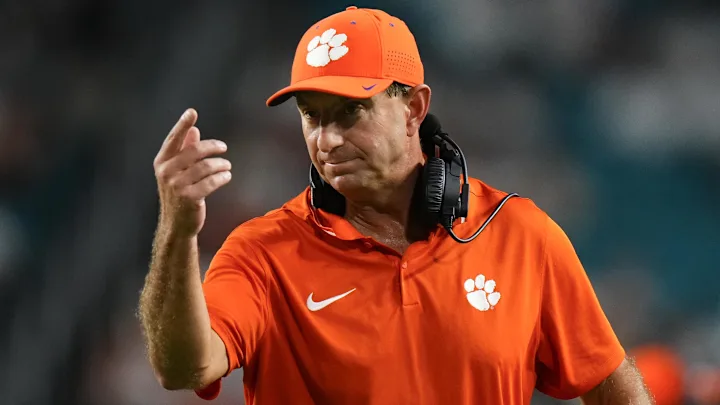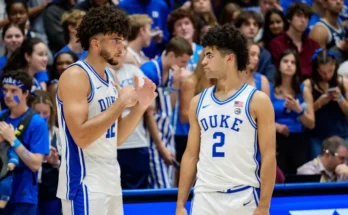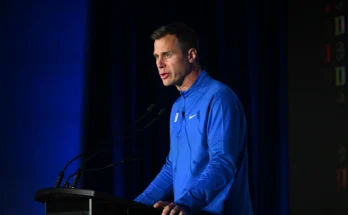Running back needs are a concern that the Clemson football coach acknowledges.
In the high-stakes, fast-paced world of college football, where championships are won and lost based on strategy, talent, and execution, one of the most important roles on the team is the running back. A good running back can be the backbone of an offense, providing a balance to the passing game and opening up opportunities for play-action and other critical offensive strategies. For Clemson University, a program that has experienced its fair share of success in recent years, the role of running back has been an evolving story marked by challenges, adjustments, and shifting expectations. As the Clemson Tigers march toward the future, the need for strong, consistent running back play is an issue that their head coach, Dabo Swinney, has repeatedly acknowledged as a concern.
Clemson has traditionally been a powerhouse in college football, with an offense that has been dominated by explosive, high-powered passing attacks in recent seasons. Yet, even with the rise of quarterbacks like Deshaun Watson and Trevor Lawrence, who showcased elite throwing abilities, running backs have continued to play a significant role in the team’s overall strategy. The ground game has always served as a balance to the passing game and has provided the team with a way to dominate in the trenches. However, as Swinney and his coaching staff have noticed, maintaining depth and consistency at the running back position has been a growing challenge in recent seasons.
The Evolution of Clemson’s Running Back Program
To fully understand the gravity of Clemson’s running back situation, it’s important to first take a look at the history and evolution of the position within the program. Over the years, Clemson has had several standout running backs who have contributed greatly to the team’s success. From C.J. Spiller to Wayne Gallman, the Tigers have been fortunate enough to boast elite talent at running back, a position that has been a vital cog in their offensive machine. These players played significant roles in the program’s national championships, conference titles, and overall success.
However, in recent years, there has been a noticeable shift. While Clemson still attracts top-tier recruits at the running back position, the depth and consistency that were once a hallmark of the program have been tested. With the departure of key players, such as Travis Etienne, who was the focal point of the Tigers’ running game for several seasons, Clemson has found itself facing a transition period in the backfield.
Etienne was one of the most dynamic running backs in college football history. His combination of speed, power, and receiving ability made him a dual-threat on the ground and through the air. He left an indelible mark on the program and set numerous records. His departure left a significant hole in Clemson’s offense, as the team had to find a way to replace his production.
The loss of such a dominant player highlighted the broader issue at running back for the Tigers: the challenge of maintaining depth and consistency in a highly competitive environment. With the transition to a new era, Swinney and the coaching staff had to take a step back and reassess their running back situation.
The Challenge of Depth
One of the most pressing concerns for Clemson has been the lack of depth at the running back position. While the Tigers have a few talented players, the consistent production that the program once had at this position has not been as evident in recent seasons. A strong running game typically relies on a stable of running backs that can rotate in and out of the game, providing fresh legs and offering different styles of play. This depth is essential, not only to keep defenses guessing but also to withstand the physical toll that comes with the demands of a long season.
For Clemson, the depth issue became particularly noticeable as key players were injured or underperformed. The team struggled to find a consistent second option behind Etienne, and the lack of a reliable backup or rotational players hurt the Tigers’ offense. This problem was compounded by the increasing tendency in college football to favor passing offenses, which at times led to the running game being underutilized or neglected.
Swinney has been vocal about the need to develop running backs who can step up when the primary ball carrier is unavailable. The coach understands that running back depth is not just about having talented players, but also about developing a system where each running back can contribute meaningfully to the offense. This requires not only talent but also experience and familiarity with the offensive scheme.
The Search for Stability and Consistency
The ongoing search for a stable and consistent running back core is another key aspect of the concern that Swinney has expressed. While Clemson has recruited highly touted running backs in recent years, the development of these players into reliable contributors has been slower than expected. Some players have shown flashes of brilliance, but consistency has been the missing ingredient.
As the coaching staff evaluates the running back situation, they are looking for players who can execute the offense as designed while also being able to take over games when necessary. In the modern landscape of college football, where games can often be decided by a handful of key plays, a dependable running back can be the difference between a win and a loss. For Clemson, the need for a running back who can perform at a high level week in and week out has become a top priority.
One of the challenges Swinney has faced is ensuring that his running backs are not only productive in short-yardage situations but also able to contribute in the passing game. College football offenses have become increasingly versatile, and running backs must now be able to catch passes, block in pass protection, and perform as multi-dimensional threats. Clemson has had some success in this area, but the balance between the run and the pass remains a critical part of the team’s offensive identity.
Recruitment and Development
In order to address the running back concerns, Swinney and his staff have turned to the recruiting trail, looking to bring in talented players who can fill the void left by Etienne and other key players. Recruiting has always been a cornerstone of Clemson’s success, and the Tigers have continued to attract some of the best high school running back prospects in the country.
However, simply recruiting talented players is not enough. The development of those players once they arrive on campus is just as important. Clemson’s coaching staff has made it clear that they are committed to developing a strong running back room, and this includes not only recruiting high school talent but also providing these players with the tools to succeed at the collegiate level. This development process includes everything from improving ball security and vision to mastering blocking schemes and route running.
Clemson’s success in recruiting and developing running backs will be crucial moving forward, especially as the program continues to battle elite teams from across the country. The ability to balance a potent passing attack with a strong, consistent running game is essential to remaining competitive at the highest level of college football.
Looking Ahead: The Future of Clemson’s Running Back Position
As Swinney looks ahead, the running back position remains one of the most important areas of focus for Clemson. While there is optimism about the talent in the current and incoming classes, there is also recognition that the team must continue to adapt and evolve in order to stay ahead of the competition. With the right balance of talent, depth, and consistency, Clemson can once again have a dominant running game to complement its high-flying passing attack.
The key to success will be the development of young players and the ability to sustain depth throughout the season. The running back by committee approach, which has been effective for many successful programs, might become the solution for Clemson as it moves forward. With the right players in place, Swinney is confident that Clemson can once again field a running back unit that will help the Tigers compete for championships.
In conclusion, while the running back position has been a concern for Clemson football in recent years, the program has the necessary resources, coaching staff, and talent pipeline to address this issue. With Dabo Swinney at the helm, the Tigers will continue to build and refine their offensive strategy, ensuring that the running back position plays a key role in their success moving forward. Whether it’s through recruiting, player development, or finding the right combination of talent, Clemson is poised to once again find stability and consistency at running back—a critical element in their quest for future championships.



